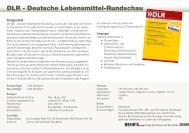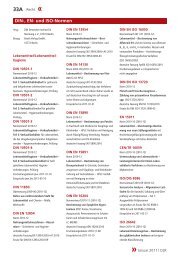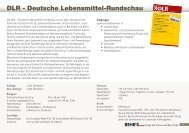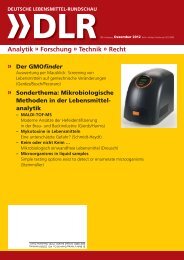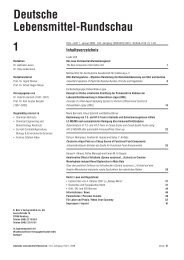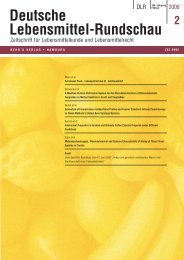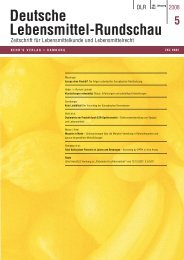Nanotechnologie in Lebensmitteln - DLR Online: Deutsche ...
Nanotechnologie in Lebensmitteln - DLR Online: Deutsche ...
Nanotechnologie in Lebensmitteln - DLR Online: Deutsche ...
Erfolgreiche ePaper selbst erstellen
Machen Sie aus Ihren PDF Publikationen ein blätterbares Flipbook mit unserer einzigartigen Google optimierten e-Paper Software.
46<br />
Orig<strong>in</strong>alarbeiten «<br />
References<br />
1) Rapp A, Vers<strong>in</strong>i G, Ullemeyer H: Vitis 32, 61 (1993).<br />
2) Christoph N et al.: Rebe We<strong>in</strong> 48, 350–356 (1995).<br />
3) Hoenicke K: Untersuchungen zur Bildung von 2-Am<strong>in</strong>oacetophenon im<br />
We<strong>in</strong> und Entstehung der „Untypischen Alterungsnote“ (UTA). Diss.,<br />
Univ, Hamburg, Germany, 2002.<br />
4) Hühn T: Freisetzung und Bildung von Aromastoffen aus natürlichen Vorstufen<br />
durch Hefen. Diss., Univ. Frankfurt am Ma<strong>in</strong>, Germany, 2003.<br />
5) Geßner M et al.: Rebe We<strong>in</strong> 48, 388–394 (1995).<br />
6) Köhler HJ et al.: Rebe We<strong>in</strong> 48, 424–430 (1995).<br />
7) Schwab A et al.: Rebe We<strong>in</strong> 49, 181–187 (1996).<br />
8) Köhler HJ et al.: Rebe We<strong>in</strong> 49, 213–218 (1996).<br />
9) Christoph N et al.: Rebe We<strong>in</strong> 49, 246-250 (1996).<br />
Heavy Metals Content of Some Croatian W<strong>in</strong>es<br />
Summary<br />
The heavy metals (Pb, Cd, Cu, Zn) content of different brands of Croatian<br />
red, white, rose and fruit w<strong>in</strong>es was measured by the electrochemical<br />
flow-through stripp<strong>in</strong>g chronopotentiometry (FTSCP), flame-atomic<br />
absorption spectrometry (FAAS) and Zeeman graphite furnace atomic<br />
absorption spectrometry (ZGFAAS) methods. FTCSP method has some<br />
advantages <strong>in</strong> comparison to FAAS and GFAAS methods, like e.g. possibilities<br />
of simultaneous determ<strong>in</strong>ation of all above mentioned heavy<br />
metals, very low detection limit, very easy sample preparation, and low<br />
runn<strong>in</strong>g costs of <strong>in</strong>strument and analysis. The results show that the<br />
heavy metals concentration varies significantly with the brand of w<strong>in</strong>es,<br />
but all determ<strong>in</strong>ed concentrations are significantly below the tolerable<br />
limits for above mentioned heavy metals concentration <strong>in</strong> w<strong>in</strong>es established<br />
by M<strong>in</strong>istry of Health of Republic of Croatia, OIV and European<br />
Commission Regulations. The mean concentration of heavy metals <strong>in</strong> all<br />
w<strong>in</strong>es samples <strong>in</strong>vestigated was: 9.50 µg Pb/l, 0.13 µg Cd/l, 156 µg Cu/l<br />
and 640 µg Zn/l. The evaluated daily <strong>in</strong>take of <strong>in</strong>vestigated heavy metals<br />
(1.9 µg Pb/d, 0.03 µg Cd/d, 31.2 µg Cu/d and 128 µg Zn/d) possible<br />
through the consumption of w<strong>in</strong>es was practically negligible <strong>in</strong> relation<br />
to both the total dietary daily <strong>in</strong>take (TDDI) and calculated tolerable daily<br />
<strong>in</strong>take (TDI) of these heavy metals, calculated from FAO/WHO reports.<br />
Thus, it appears that the dietary Pb, Cd, Cu and Zn <strong>in</strong>take from <strong>in</strong>vestigated<br />
w<strong>in</strong>es should not be a cause for concern with regard to possible<br />
toxicity of these heavy metals for the human body.<br />
Zusammenfassung<br />
Schwermetallgehalte (Pb, Cd, Cu, Zn) <strong>in</strong> verschiedenen kroatischen<br />
Rot-, Weiß-, Rosé- und Fruchtwe<strong>in</strong>en wurden mittels elektrochemischer<br />
Durchfluss-Stripp<strong>in</strong>g-Chronopotentiometrie (DFSCP), Flammen-Atomabsorptionsspektrometrie<br />
(FAAS) und mittels Zeeman-Grafitrohr-AAS<br />
(ZGFAAS) bestimmt. DFSCP-Methode hat e<strong>in</strong>ige Vorteile im Vergleich zu<br />
den FAAS- und GFAAS-Methoden wie z. B.: (i) Möglichkeit e<strong>in</strong>er gleichzeitigen<br />
Bestimmung aller oben genannten Schwermetalle, (ii) sehr<br />
niedrige Bestimmungsgrenzwerte, (iii) e<strong>in</strong> sehr e<strong>in</strong>facher Zubereitungsvorgang<br />
der Proben und (iv) preisgünstige Instrumente sowie Analyse.<br />
10) Geßner M et al.: Rebe We<strong>in</strong> 49, 251–255 (1996).<br />
11) Geßner M, Köhler HJ, Christoph N: Rebe We<strong>in</strong> 52, 264–267 (1999).<br />
12) Hoenicke K et al.: J Agr Food Chem 50, 4303 (2002).<br />
13) Hoenicke K et al.: Anal Chim Acta 458, 29 (2002).<br />
14) Rapp A, Vers<strong>in</strong>i G, Engel L: Vitis 34, 193 (1995).<br />
15) Hühn T, Sponholz WR, Grossmann M: We<strong>in</strong> Wissenschaft 54, 105<br />
(1999).<br />
16) Dollmann B et al.: J AOAC Int 79, 583 (1996).<br />
17) Schmarr HG et al.: J Chromatogr A 1150, 78–84 (2007).<br />
18) Fan W, Tsai I-M, Qian MC: Food Chem 105, 1144–1150 (2007).<br />
19) Pawliszyn J: Solid Phase Microextraction Theory and Practice. Wiley-<br />
VCH (1997).<br />
20) Zhang Z et al.: Anal Chem 66, 844–853 (1994).<br />
Marijan Šeruga1 , Ivana Nemet1 and Belita Laslavić2 1 Faculty of Food Technology, University of Osijek, Kuhaćeva 18, HR-<br />
31000 Osijek, Croatia, E-mail: marijan.seruga@ptfos.hr<br />
2 Institute of Public Health, F. Krežme 1, HR-31000 Osijek, Croatia<br />
Die Ergebnisse weisen darauf h<strong>in</strong>, dass die Konzentration der Schwermetalle<br />
signifikant von der Sorte des We<strong>in</strong>es abhängt. Alle hier bestimmten<br />
Konzentrationen der Schwermetalle <strong>in</strong> den We<strong>in</strong>en liegen weit<br />
unter den vom kroatischen M<strong>in</strong>isterium für Gesundheit, OIV und von<br />
der EU-Kommission festgelegten Grenzwerten. Die durchschnittlichen<br />
Konzentrationen aller geprüften We<strong>in</strong>proben betrugen wie folgt: 9,50 µg<br />
Pb/l, 0,13 µg Cd/l, 156 µg Cu/l und 640 µg Zn/l. Die bewertete mögliche<br />
Tagesaufnahme der Schwermetalle durch den We<strong>in</strong>konsum (1,90 µg<br />
Pb/d, 0,03 µg Cd/Tag, 31,2 µg Cu/d und 128 µg Zn/d) ist im Vergleich<br />
zur gesamten Schwermetallaufnahme durch Nahrung wesentlich niedriger<br />
sowie im Vergleich zum von FAO/WHO festgelegten Höchstwert<br />
der Schwermetalltagesaufnahme. E<strong>in</strong>e mögliche Schwermetallaufnahme<br />
durch den Konsum von We<strong>in</strong> stellt daher ke<strong>in</strong>en Grund zur Sorge dar.<br />
Introduction<br />
Different metals, <strong>in</strong>clud<strong>in</strong>g heavy metals, are naturally conta<strong>in</strong>ed<br />
substances <strong>in</strong> the environment, as well as <strong>in</strong> foods,<br />
waters, medicaments, etc. They can enter <strong>in</strong>to the human<br />
body on different pathways from the environment, e.g. by<br />
<strong>in</strong>halation the air and/or from the foods by <strong>in</strong>gestion.<br />
Foods could be a significant source of heavy metals <strong>in</strong>take<br />
<strong>in</strong>to the human body. Because some of heavy metals (e.g.<br />
lead, cadmium, mercury, copper, z<strong>in</strong>c, chromium) can be<br />
potential toxic for the humans (already <strong>in</strong> low or very low<br />
concentrations), there is a cont<strong>in</strong>uous and great <strong>in</strong>terest to<br />
<strong>in</strong>vestigate the content of these metals <strong>in</strong> different foods,<br />
their dietary <strong>in</strong>take, their bioavailability and toxicity for<br />
the humans 1–4) . Due to the potential toxicity of these metals<br />
the World Health Organization (WHO) and different Expert<br />
Committees and Institutions (like e.g. The Jo<strong>in</strong>t FAO/<br />
WHO Expert Committee on Food and Additives-JEFCA,<br />
European Commission’s Scientific Committee on Food-<br />
» November/Dezember 2008 | <strong>DLR</strong>




